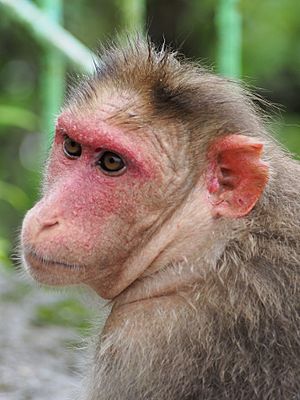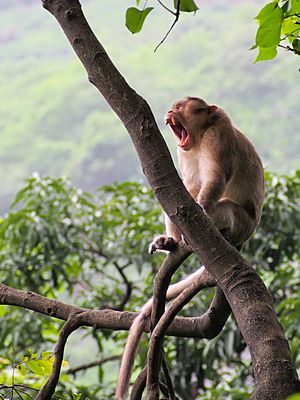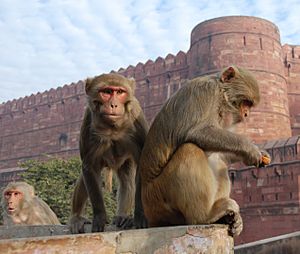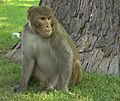Rhesus macaque facts for kids
Quick facts for kids Rhesus macaque |
|
|---|---|
 |
|
| Rhesus macaque in Satpura National Park | |
| Conservation status | |
| Scientific classification | |
| Genus: |
Macaca
|
| Species: |
mulatta
|
 |
|
| Rhesus macaque native range | |
| Synonyms | |
|
Species synonymy
|
|
The rhesus macaque (Macaca mulatta) is one of the best-known species of Old World monkeys. It is listed as Least Concern in the IUCN Red List of Threatened Species in view of its wide distribution, presumed large population, and its tolerance of a broad range of habitats. It is native to South, Central, and Southeast Asia and has the widest geographic range of all non-human primates, occupying a great diversity of altitudes and a great variety of habitats, from grasslands to arid and forested areas, but also close to human settlements.
Contents
Characteristics

The rhesus macaque is brown or grey in color and has a pink face, which is bereft of fur. It has, on average, 50 vertebrae, a dorsal scapulae and a wide rib cage. Its tail averages between 20.7 and 22.9 cm (8.1 and 9.0 in). Adult males measure about 53 cm (21 in) on average and weigh about 7.7 kg (17 lb). Females are smaller, averaging 47 cm (19 in) in length and 5.3 kg (12 lb) in weight. The ratio of arm length to leg length is 89%.
The rhesus macaque has a dental formula of 2.1.2.32.1.2.3 × 2 = 32 and bilophodont molar teeth.
Distribution and habitat
Rhesus macaques are native to India, Bangladesh, Pakistan, Nepal, Burma, Thailand, Afghanistan, Vietnam, southern China, and some neighboring areas. They have the widest geographic ranges of any non-human primate, occupying a great diversity of altitudes throughout Central, South, and Southeast Asia. Inhabiting arid, open areas, rhesus macaques may be found in grasslands, woodlands, and in mountainous regions up to 2,500 m (8,200 ft) in elevation. They are regular swimmers. Babies as young as a few days old can swim, and adults are known to swim over a half mile between islands, but are often found drowned in small groups where their drinking waters lie. Rhesus macaques are noted for their tendency to move from rural to urban areas, coming to rely on handouts or refuse from humans. They adapt well to human presence, and form larger troops in human-dominated landscapes than in forests.
The southern and the northern distributional limits for rhesus and bonnet macaques, respectively, currently run parallel to each other in the western part of India, are separated by a large gap in the center, and converge on the eastern coast of the peninsula to form a distribution overlap zone. This overlap region is characterized by the presence of mixed-species troops, with pure troops of both species sometimes occurring even in close proximity to one another. The range extension of rhesus macaque – a natural process in some areas, and a direct consequence of introduction by humans in other regions – poses grave implications for the endemic and declining populations of bonnet macaques in southern India.
The Thai population is locally classified as endangered. There are about 1,000 troops at Wat Tham Pha Mak Ho, Tambon Si Songkhram, Wang Saphung district, Loei province.
Distribution of subspecies and populations
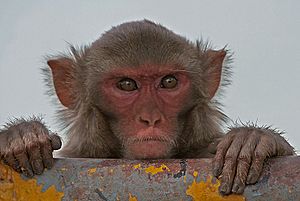
The name "rhesus" is reminiscent of the mythological king Rhesus of Thrace, a minor character in the Iliad. However, the French naturalist Jean-Baptiste Audebert, who applied the name to the species, stated: "it has no meaning".
According to Zimmermann’s first description of 1780, the rhesus macaque is distributed in eastern Afghanistan, Bangladesh, Bhutan, as far east as the Brahmaputra Valley in peninsular India, Nepal, and northern Pakistan. Today, this is known as the Indian rhesus macaque M. m. mulatta, which includes the morphologically similar M. rhesus villosus, described by True in 1894, from Kashmir, and M. m. mcmahoni, described by Pocock in 1932 from Kootai, Pakistan. Several Chinese subspecies of rhesus macaques were described between 1867 and 1917. The molecular differences identified among populations, however, are alone not consistent enough to conclusively define any subspecies.
Ecology and behavior

Rhesus macaques are diurnal animals, and both arboreal and terrestrial. They are quadrupedal and, when on the ground, they walk digitigrade and plantigrade. They are mostly herbivorous, feeding mainly on fruit, but also eating seeds, roots, buds, bark, and cereals. They are estimated to consume around 99 different plant species in 46 families. During the monsoon season, they get much of their water from ripe and succulent fruit. Macaques living far from water sources lick dewdrops from leaves and drink rainwater accumulated in tree hollows. They have also been observed eating termites, grasshoppers, ants, and beetles. When food is abundant, they are distributed in patches, and forage throughout the day in their home ranges. They drink water when foraging, and gather around streams and rivers. Rhesus macaques have specialized pouch-like cheeks, allowing them to temporarily hoard their food.
In psychological research, rhesus macaques have demonstrated a variety of complex cognitive abilities, including the ability to make same-different judgments, understand simple rules, and monitor their own mental states. They have even been shown to demonstrate self-agency, an important type of self-awareness. In 2014, onlookers at a train station in Kanpur, India, documented a rhesus monkey, knocked unconscious by overhead power lines, that was revived by another rhesus that systematically administered a series of resuscitative actions.
Group structure
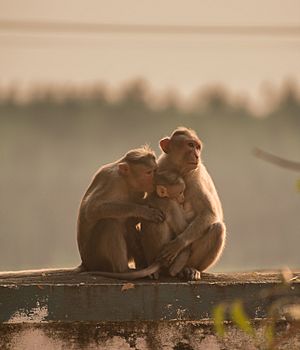
Like other macaques, rhesus troops comprise a mixture of 20–200 males and females. Females may outnumber the males by a ratio of 4:1. Males and females both have separate hierarchies. Female philopatry, common among social mammals, has been extensively studied in rhesus macaques. Females tend not to leave the social group, and have highly stable matrilineal hierarchies in which a female’s rank is dependent on the rank of her mother. In addition, a single group may have multiple matrilineal lines existing in a hierarchy, and a female outranks any unrelated females that rank lower than her mother. Rhesus macaques are unusual in that the youngest females tend to outrank their older sisters. This is likely because young females are more fit and fertile. Mothers seem to prevent the older daughters from forming coalitions against her. The youngest daughter is the most dependent on the mother, and would have nothing to gain from helping her siblings in overthrowing their mother. Since each daughter had a high rank in her early years, rebelling against her mother is discouraged. Juvenile male macaques also exist in matrilineal lines, but once they reach four to five years of age, they are driven out of their natal groups by the dominant male. Thus, adult males gain dominance by age and experience.
In the group, macaques position themselves based on rank. The "central male subgroup" contains the two or three oldest and most dominant males which are codominant, along with females, their infants, and juveniles. This subgroup occupies the center of the group and determines the movements, foraging, and other routines. The females of this subgroup are also the most dominant of the entire group. The farther to the periphery a subgroup is, the less dominant it is. Subgroups on the periphery of the central group are run by one dominant male, of a rank lower than the central males, and he maintains order in the group, and communicates messages between the central and peripheral males. A subgroup of subordinate, often subadult, males occupy the very edge of the groups, and have the responsibility of communicating with other macaque groups and making alarm calls. Rhesus social behaviour has been described as despotic, in that high-ranking individuals often show little tolerance, and frequently become aggressive towards non-kin.
Communication
Rhesus macaques interact using a variety of facial expressions, vocalizations, body postures, and gestures. Perhaps the most common facial expression the macaque makes is the "silent bared teeth" face. This is made between individuals of different social ranks, with the lower-ranking one giving the expression to its superior. A less-dominant individual also makes a "fear grimace", accompanied by a scream, to appease or redirect aggression. Another submissive behavior is the "present rump", where an individual raises its tail and exposes its private parts to the dominant one. A dominant individual threatens another individual by standing quadrupedally and making a silent "open mouth stare" accompanied by the tail sticking straight. During movements, macaques make coos and grunts.
In science
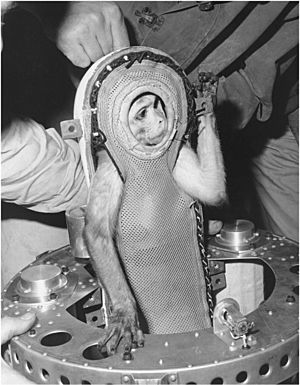
The rhesus macaque is well known to science. Due to its relatively easy upkeep in captivity, wide availability, and closeness to humans anatomically and physiologically, it has been used extensively in medical and biological research on human and animal health-related topics. It has given its name to the Rh factor, one of the elements of a person's blood group, by the discoverers of the factor, Karl Landsteiner and Alexander Wiener. The rhesus macaque was also used in the well-known experiments on maternal deprivation carried out in the 1950s by comparative psychologist Harry Harlow. Other medical breakthroughs facilitated by the use of the rhesus macaque include:
- development of the rabies, smallpox, and polio vaccines
- creation of medicines to manage HIV/AIDS
- understanding of the female reproductive cycle and development of the embryo and the propagation of embryonic stem cells.
The U.S. Army, the U.S. Air Force, and NASA launched rhesus macaques into outer space during the 1950s and 1960s, and the Soviet/Russian space program launched them into space as recently as 1997 on the Bion missions. Albert II became the first primate and first mammal in space during a U.S. V-2 rocket suborbital flight on 14 June 1949, and died on impact when a parachute failed.
Another rhesus monkey, Able, was launched on a suborbital spaceflight in 1959, and was among the first living beings (along with Miss Baker, a squirrel monkey on the same mission) to travel in space and return alive.
On 25 October 1999, the rhesus macaque became the first cloned primate with the birth of Tetra. January 2001 had the birth of ANDi, the first transgenic primate; ANDi carries foreign genes originally from a jellyfish.
Though most studies of the rhesus macaque are from various locations in northern India, some knowledge of the natural behavior of the species comes from studies carried out on a colony established by the Caribbean Primate Research Center of the University of Puerto Rico on the island of Cayo Santiago, off Puerto Rico. No predators are on the island, and humans are not permitted to land except as part of the research programmes. The colony is provisioned to some extent, but about half of its food comes from natural foraging.
Rhesus macaques, like many macaques, carry the herpes B virus. This virus does not typically harm the monkey, but is very dangerous to humans in the rare event that it jumps species, for example in the 1997 death of Yerkes National Primate Research Center researcher Elizabeth Griffin.
Conservation status
The rhesus macaque is listed as Least Concern on the IUCN Red List and estimated to exist in large numbers; it is tolerant of a broad range of habitats, including urban environments. It has the largest natural range of any non-human primate. The Thai population is locally threatened. In addition to habitat destruction and agricultural encroachment, pet releases of the different species into existing troops are diluting the gene pool and putting its genetic integrity at risk. Despite the wealth of information on its ecology and behaviour, little attention has been paid to its demography or population status, which can pose a risk for future Rhesus macaque populations. The extension of its distributional limits by approximately 3,500 km2 (1,400 sq mi) in southeast India caused population stress on other species. This range extension has been caused by human intervention tactics whereby village translocation occurs from urban conflict ridden areas.
Images for kids
See also
 In Spanish: Macaco Rhesus para niños
In Spanish: Macaco Rhesus para niños



